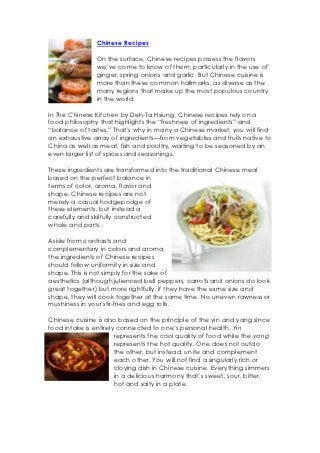
Chinese recipes
- 1. Chinese Recipes On the surface, Chinese recipes possess the flavors we’ve come to know of them, particularly in the use of ginger, spring onions and garlic. But Chinese cuisine is more than these common hallmarks, as diverse as the many regions that make up the most populous country in the world. In The Chinese Kitchen by Deh-Ta Hsiung, Chinese recipes rely on a food philosophy that highlights the “freshness of ingredients” and “balance of tastes.” That’s why in many a Chinese market, you will find an exhaustive array of ingredients—from vegetables and fruits native to China as well as meat, fish and poultry, waiting to be seasoned by an even larger list of spices and seasonings. These ingredients are transformed into the traditional Chinese meal based on the perfect balance in terms of color, aroma, flavor and shape. Chinese recipes are not merely a casual hodgepodge of these elements, but instead a carefully and skilfully constructed whole and parts. Aside from contrasts and complementary in colors and aroma, the ingredients of Chinese recipes should follow uniformity in size and shape. This is not simply for the sake of aesthetics (although julienned bell peppers, carrots and onions do look great together) but more rightfully, if they have the same size and shape, they will cook together at the same time. No uneven rawness or mushiness in your stir-fries and egg rolls. Chinese cuisine is also based on the principle of the yin and yang since food intake is entirely connected to one’s personal health. Yin represents the cool quality of food while the yang represents the hot quality. One does not outdo the other, but instead, unite and complement each other. You will not find a singularly rich or cloying dish in Chinese cuisine. Everything simmers in a delicious harmony that’s sweet, sour, bitter, hot and salty in a plate.
